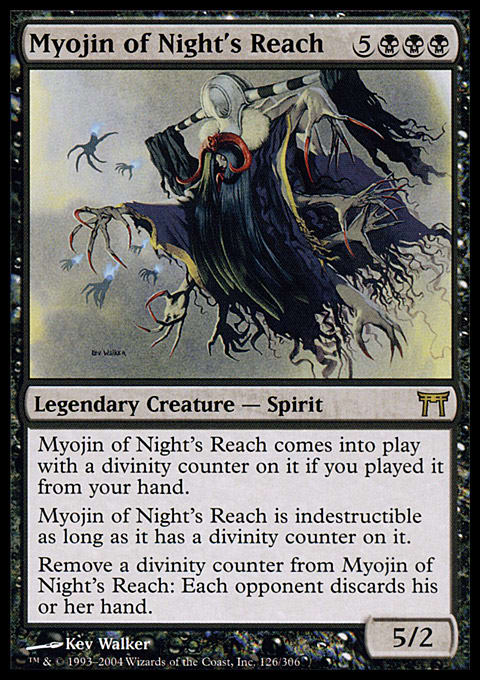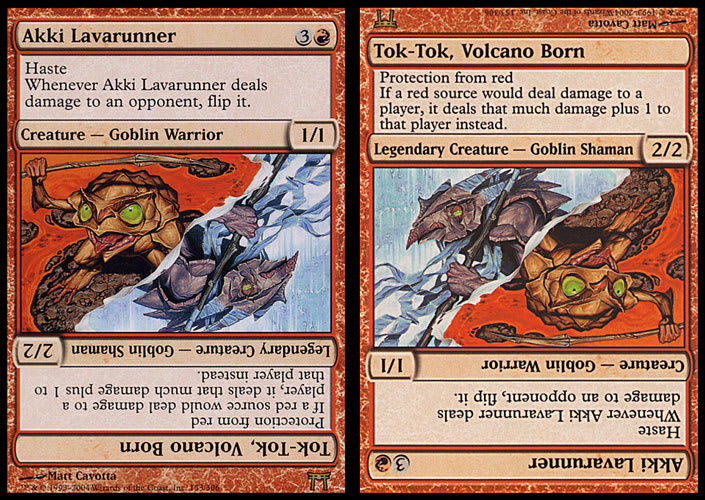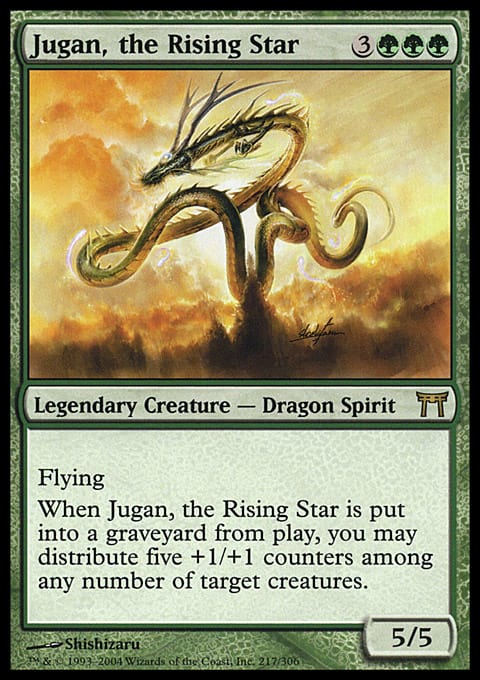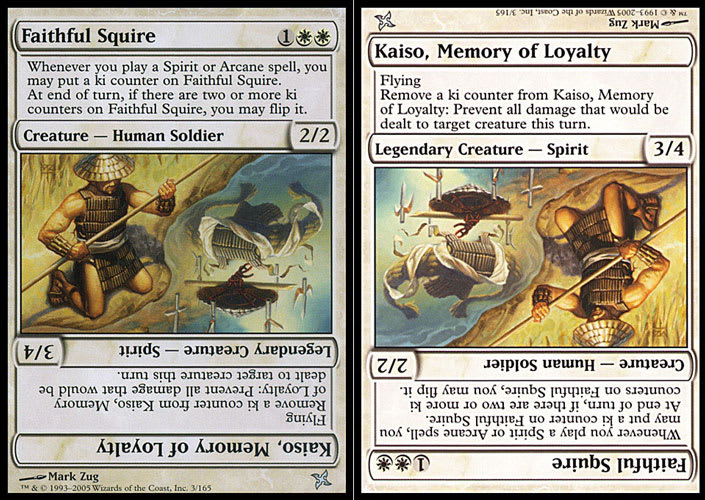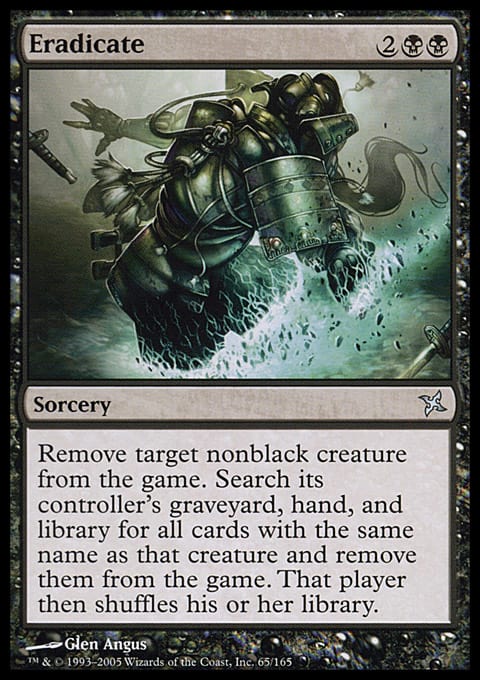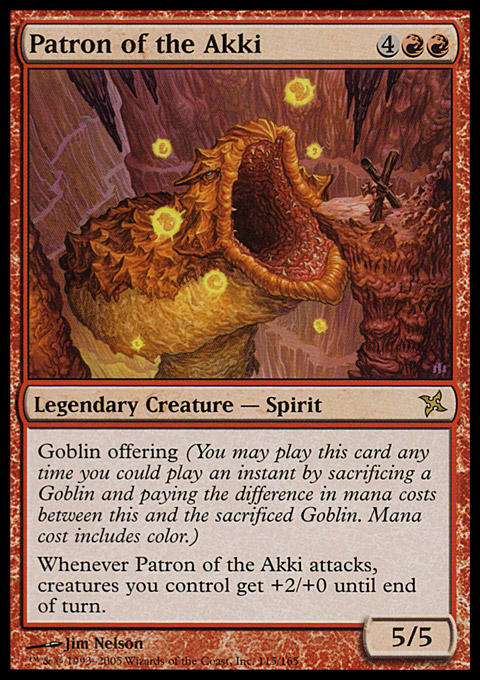I’m trying to hurry through this block to make it to Ravnica. Looking back, that’s sort of how it felt—as though Kamigawa were the commercial interruption between normal Magic blocks. But that doesn’t mean the block only works with itself or that it’s dull. There’s plenty of awesomeness across formats once you dig enough, and taking a hold of the various cycles—there are so many that Saviors of Kamigawa has its own article—helps solidify what is, to many, a hard block to remember.
A reminder of the parameters:
- I’m looking at horizontal cycles (Titans), not vertical cycles (Penumbra Bobcat/Penumbra Kavu/Penumbra Wurm). They need at least five cards, though they don’t have to be in five colors.
- No all-common cycles. They tend to be boring.
- No land/mana cycles. They tend to be too similar for my purposes. Besides, every dual land is good.
I’m grading each cycle on three categories:
- Playability – Does this cycle have any cards people want to play?
- Depth – Was it hit-or-miss or strong overall?
- Resonance – Memorable cycles should be able to pass the flavor test, although some cycles are mechanical and are not intended to have shared flavor. Still, making all the cards cost the same, have similar names, or share other characteristics can make a cycle memorable when it otherwise wouldn’t be.
With that said, show some Spirit as we go to the cards!
Champions of Kamigawa
Nezumi Graverobber and Some Other Cards
(Bushi Tenderfoot, Student of Elements, Nezumi Graverobber, Initiate of Blood, Orochi Eggwatcher)
Playability: B+
Depth: B
Resonance: B
The upside of almost all these has always been . . . decent. Nezumi Graverobber has an easy flip trigger and high upside; put them together, and you have a winner. Student of Elements has the easiest flip trigger, but giving it flying is best accomplished in most decks by giving all your creatures flying, which is all Student of Elements attempts anyway. Bushi Tenderfoot is fantastic when it’s Kenzo the Hardhearted, but try as I might (and I’ve tried for years), the circumstances are just too narrow to make it work. Initiate of Blood and Orochi Eggwatcher do their things well enough, but unless you specifically need extra damage or Snake tokens, they’re just okay.
Flip cards could hold little text comfortably, and the two-sided art is confusing; it’s hard to be resonant with those constraints. The only boost to this cycle’s resonance besides their flipness is that the unflipped sides generally have learner’s-permit names, with Tenderfoot, Student, and Initiate. As uncommons go, these served the block’s needs, but only Nezumi Graverobber’s graduated to classic status.
The Hondens
(Honden of Cleansing Fire, Honden of Seeing Winds, Honden of Night's Reach, Honden of Infinite Rage, Honden of Life's Web)
Playability: B
Depth: B
Resonance: B+
I assume that if you know Japanese culture, you know these are resonant. That’s a flavor issue with the whole block: There’s so much unfamiliar flavor that you assume the flavor matches well enough and just go by whether it seems cool. But as not only legendary enchantments but the only five Shrines, they’re plenty memorable otherwise. As we’ll see with the Myojins, Wizards of the Coast missed an opportunity for extra resonance, but that’s okay. (They do pick up points with their parallel flavor texts, starting with “To the sorrow of all, its [thing in title].”)
They’re meant to play together in some five-color conflagration, although any pair of them is usually fine. Honden of Seeing Winds as reliable card-draw is the Shrine most easily included outside the cycle, and occasionally, you want the discard of Honden of Night's Reach, but that’s about it. I’ve known more casual players build the Zubera deck than the Honden deck, but I assume bringing all the Hondens out is loads of fun. It should be a cheap deck to try if you’re interested in taking up the challenge.
The Myojins
(Myojin of Cleansing Fire, Myojin of Seeing Winds, Myojin of Night's Reach, Myojin of Infinite Rage, Myojin of Life's Web)
Playability: A−
Depth: B+
Resonance: B+
Despite their ineffectiveness leading a Commander deck, they’re solid for their combination of abilities: a relevant creature type, indestructibility, and a free activated ability useful in multiplayer. Myojin of Cleansing Fire is my favorite, but the others have seen plenty of play. They’re a bajillion mana, so not every deck wants them, but those that do find these to be valuable support. That’s not to say they’re good at ending games, which is why they’re always a notch below, say, the Invasion Dragons, but they have their moments.
The Hondens share names, sorted by color, with the Myojins. So, why did Kev Walker illustrate all the creatures while five different artists illustrated all the enchantments? While having one artist illustrate all ten might have overdone it, why not have five artists each draw a corresponding Myojin and Honden? I have no idea how the cards are connected, but the names say they are. It seems weird to stop the connection at names.
The Rare Flippers
(Kitsune Mystic, Jushi Apprentice, Nezumi Shortfang, Akki Lavarunner, Budoka Gardener)
Playability: A−
Depth: C
Resonance: B
These have the same problems as the uncommon flip creatures: There isn’t enough space to convey the whats and whys apart from game play. Jushi Apprentice was the namesake of one of the last mono-blue control decks in Standard, Jushi Blue, which used it for consistent card-draw when there was nothing else to do. Kitsune Mystic has some Commander viability, invigorated by Bruna, Light of Alabaster. The rest have a chance of being good, but they normally fall short of my hopes for them. It’s sort of hard to remember them as a cycle, but it helped make a Standard deck, so it scores all right.
Dragon, the Legend Rule
(Yosei, the Morning Star, Keiga, the Tide Star, Kokusho, the Evening Star, Ryusei, the Falling Star, Jugan, the Rising Star)
Playability: A
Depth: A−
Resonance: A
Falling just short of top marks (because I don’t want the Anti-Jugan League to throw peas and paperclips at me), these were marketed heavily and succeeded across formats, with Kokusho banned early in then-EDH. Helping the marketing was the change in the legend rule. Initially, a legend in play meant you couldn’t play a legend of the same name. This was a problem in tournaments with Lin Sivvi, Defiant Hero and Akroma, Angel of Wrath mirror matches, as the first person to cast the legend usually won. Champions of Kamigawa invented the supertype to obviate the legend creature type (making basic a supertype of land as well), accommodating the block increase in legends while fixing tournaments. It seemed odd to errata as many cards as the change required, but it wound up elegant.
And these Dragons uniquely reinforced the rules change by having graveyard triggers that encouraged playing duplicates. Kokusho’s was brutal enough to crack the tournament barrier specifically off the duplicates, though Keiga and Yosei had star power as single entities. This might be the only cycle whose resonance and visibility were enhanced by a rules change. Very well done.
Betrayers of Kamigawa
Never a Ki Card in a Good Deck
(Faithful Squire, Callow Jushi, Hired Muscle, Cunning Bandit, Budoka Pupil)
Playability: C
Depth: B+
Resonance: B−
These aren’t worth the amount of text on them. As flip creatures, they were going to be cramped anyway, but their abilities are wordy. Consequently, they have less resonance than other flip creatures because you have to squint at them the whole time.
Each creature is a 2/2 for 1CC that receives a ki counter when you cast a Spirit or Arcane spell. Once you’ve done this twice, a trigger happens at the end step to flip the creature into a bigger creature with an ability that removes the ki counters. There’s a neat in-game tension on when to flip since you want more ki counters on the flipped side, but none of the abilities are so awesome that you’d feel compelled to build around them. I love a strange, complex card, and these even feel well designed, but the sum is less than the parts. The time it takes to explain and re-explain these cards is better spent elsewhere. (Cool side note, though: Cunning Bandit’s flip side, Azimuki, Treachery Incarnate, is one of the only temporary steal effects that doesn’t give haste.)
The Genjus
(Genju of the Fields, Genju of the Falls, Genju of the Fens, Genju of the Spires, Genju of the Cedars, Genju of the Realm)
Playability: B
Depth: B+
Resonance: B+
This is one of the most loved cycles of both Kamigawa block and Auras on lands. That’s narrow praise in either case, but these are serviceable for many a random deck. The five mono-colored Auras each enchant a different land type (i.e. Genju of the Fields enchants only a Plains), lets that land turn into a (usually) French vanilla creature, and the Genju goes back to your hand if the creature land dies. They’re not on par with Rancor, but they come surprisingly close.
Genju of the Fields is the best known for taking advantage of old lifelink: If you activate the Genju multiple times on the same turn, you’ll give the creature land that many instances of life-gain. Genju of the Realm, the five-color sixth member that makes the land an 8/12 trampler, is my favorite for Commander fun. But each Genju is good value regardless of whether you build around it, and unlike the cycle just talked about, their wordiness is well worth it.
Reprinted Utility
(Scour, Quash, Eradicate, Sowing Salt, Splinter)
Playability: B
Depth: A
Resonance: B−
I’m giving the same grades as when this cycle was in Urza’s Destiny. As I explained in that article, “They’re a touch slow and narrow, but they’ll make sure you’re not dealing with the problematic permanent again, and that’s well worth the tradeoff in speed for several playgroups.” It’s a mechanical cycle with no flavor text, and Sowing Salt’s name breaks the symmetry of the other four names, so it’s not as resonant as its tight mana costs and simplicity would give it, but it’s as useful to casual players now as it ever was.
This is also the first uncommon/rare cycle to be reprinted intact outside a core set; correct me in the comments if my memory’s off, but the shock lands coming back in Return to Ravnica is the second. Should you find yourself in a Magic trivia game, there’s one for you.
The Patrons
(Patron of the Kitsune, Patron of the Moon, Patron of the Nezumi, Patron of the Akki, Patron of the Orochi)
Playability: B+
Depth: A−
Resonance: B
A largely mechanical cycle linked by name and partially by a tribal ability, the Patrons have done solid casual work over the years, largely off their extra abilities. Each is a large legendary creature that has pseudo-flash and becomes cheaper if you sacrifice a creature of the appropriate type; they’re cheaper to cast by the converted mana cost of the sacrificed creature. It’s interesting design space that for now remains undeveloped.
But while these Spirits can highlight an appropriate tribal deck (Fox, Moonfolk, Rat, Goblin, and Snake, respectively), several are playable without the offering. Patrons of the Moon, Nezumi, and Orochi have abilities that aren’t on any other card; in Nezumi’s case, that uniqueness got it a well-deserved reprint in the Commander product. It’s rare to find cards with multiple unique abilities, but to make a cycle of them is impressive. Reading them doesn’t give you that wow factor a mythic is supposed to give, but as a design connoisseur, these are mythically good.
The Shoals
(Shining Shoal, Disrupting Shoal, Sickening Shoal, Blazing Shoal, Nourishing Shoal)
Playability: A
Depth: B+
Resonance: A−
Perhaps the most iconic pitch spells outside Force of Will, the Shoals can be free if you exile a card whose color matches the Shoal you’re casting; the converted mana cost of the exiled card determines X for the spell. They’re all Arcane instants, though that hasn’t mattered much over the years. What’s mattered is their utility at any stage of the game, their chance to be free, and their combo potential. Sickening and Disrupting Shoal were just plain good in their heyday (Nourishing Shoal never was), and Shining Shoal is one of the best damage redirects available to casual players, but Blazing Shoal’s been broken in half in enough decks that it’s banned in Modern.
Before Modern, there was a deck whose primary goal was to cast Spark Elemental, exile two Greater Gargadons to two Blazing Shoals, and swing for 23 trample damage. With those five cards and a Mountain, the dream hand could kill on turn one. When Modern started, infect’s road to victory required less pump than Spark Elemental, so the deck was much easier to put together; it only took one Pro Tour before Wizards decided that wasn’t a healthy environment. Infect combo will always be around, but not quite like it is with Blazing Shoal.
As far as resonance, they share a spell type, a mana cost of XCC, and half of a name, but what links them together most is the artwork. The spell is meant to be an actual shoal of fish, like what’s on Eerie Procession. And eerie’s the right word; even Nourishing Shoal gains life off some creepy doom fish. Once you study the artwork, you can’t forget it; that helps make a memorable cycle.
Conclusion
The flip creatures were memorable more for their novelty than for being in cycles, but the rest turned out quite well. And the rest aren’t just about Kamigawa flavor; their abilities tend to be unusual and useful. If the whole block had been designed like these cycles, it would have been better received, I think. For all the weird flavor you might or might not have liked about Kamigawa, there were some great cycles that came out of it.
















